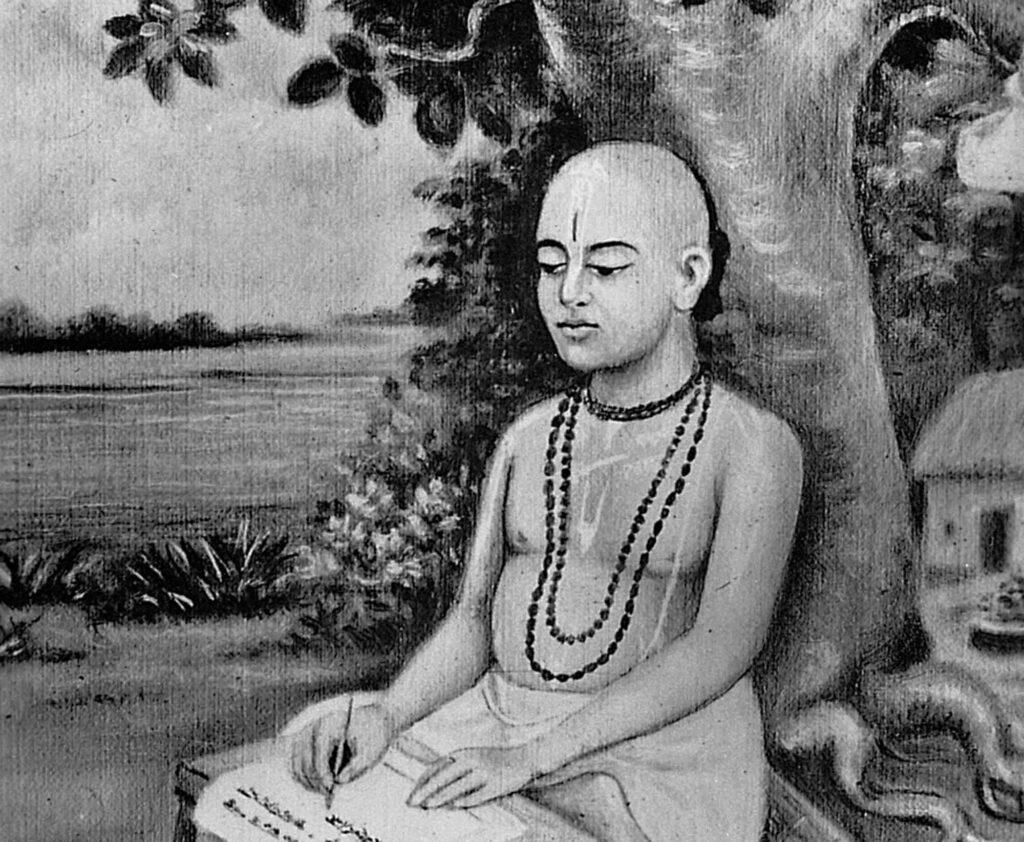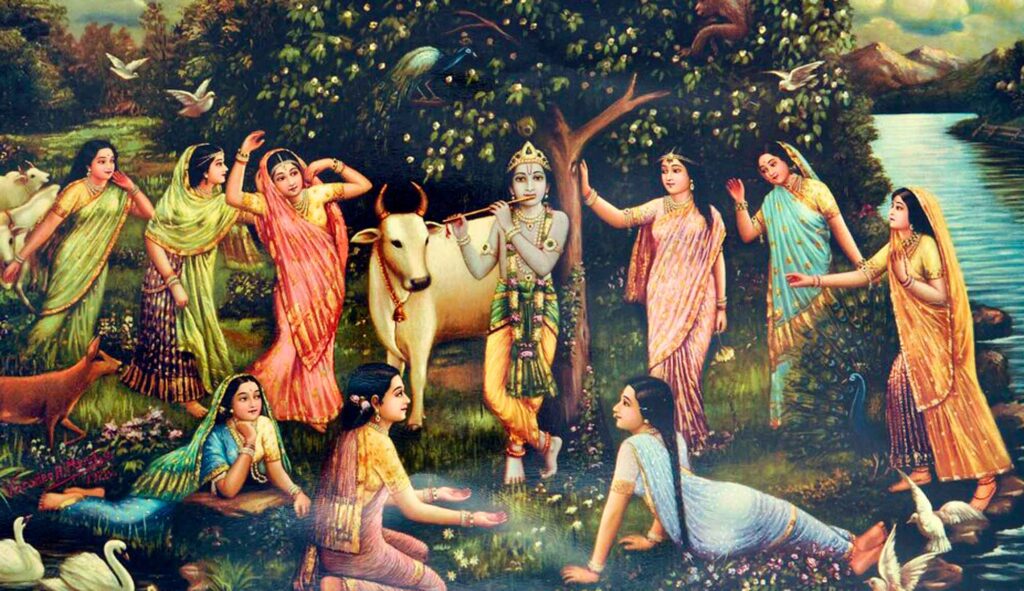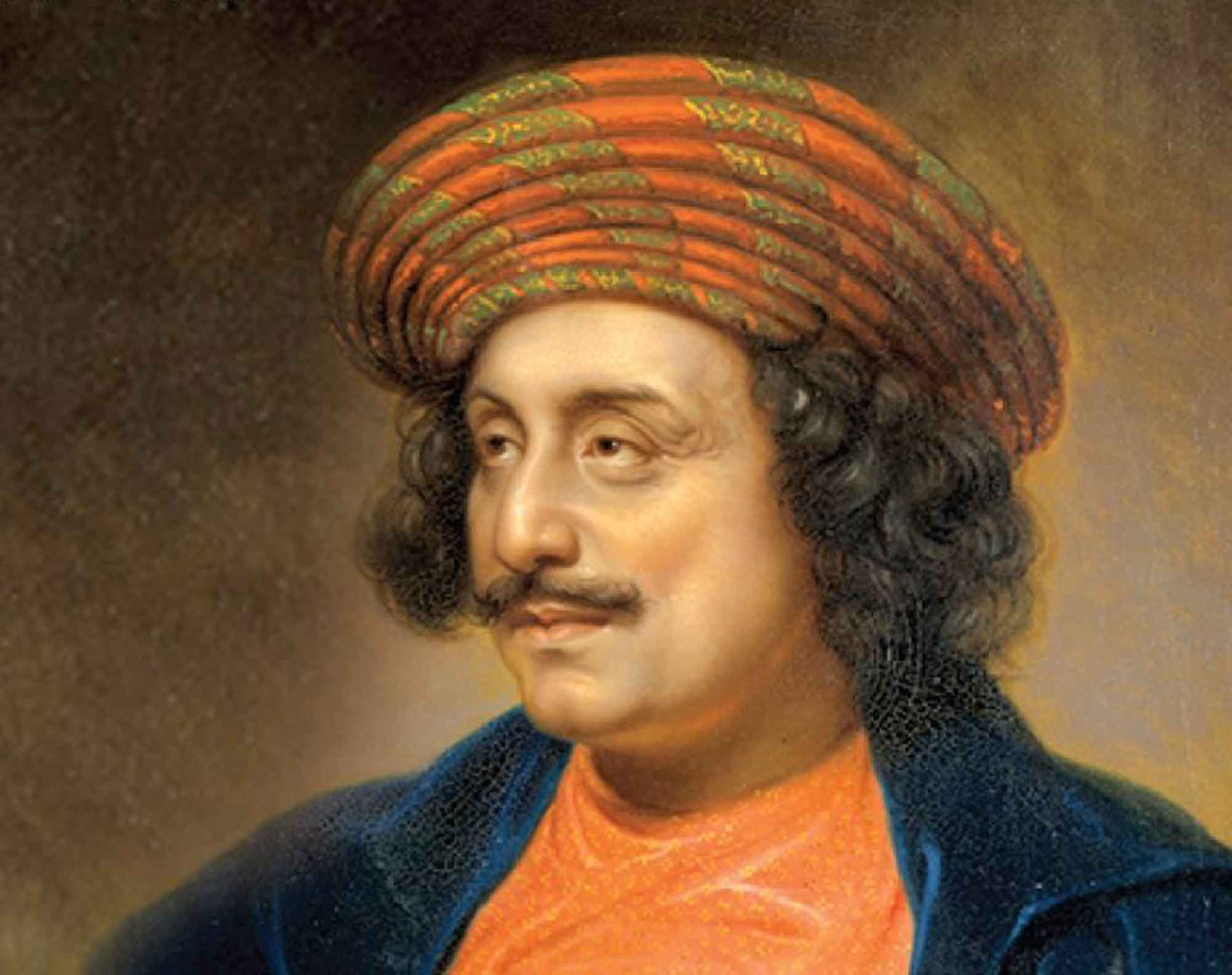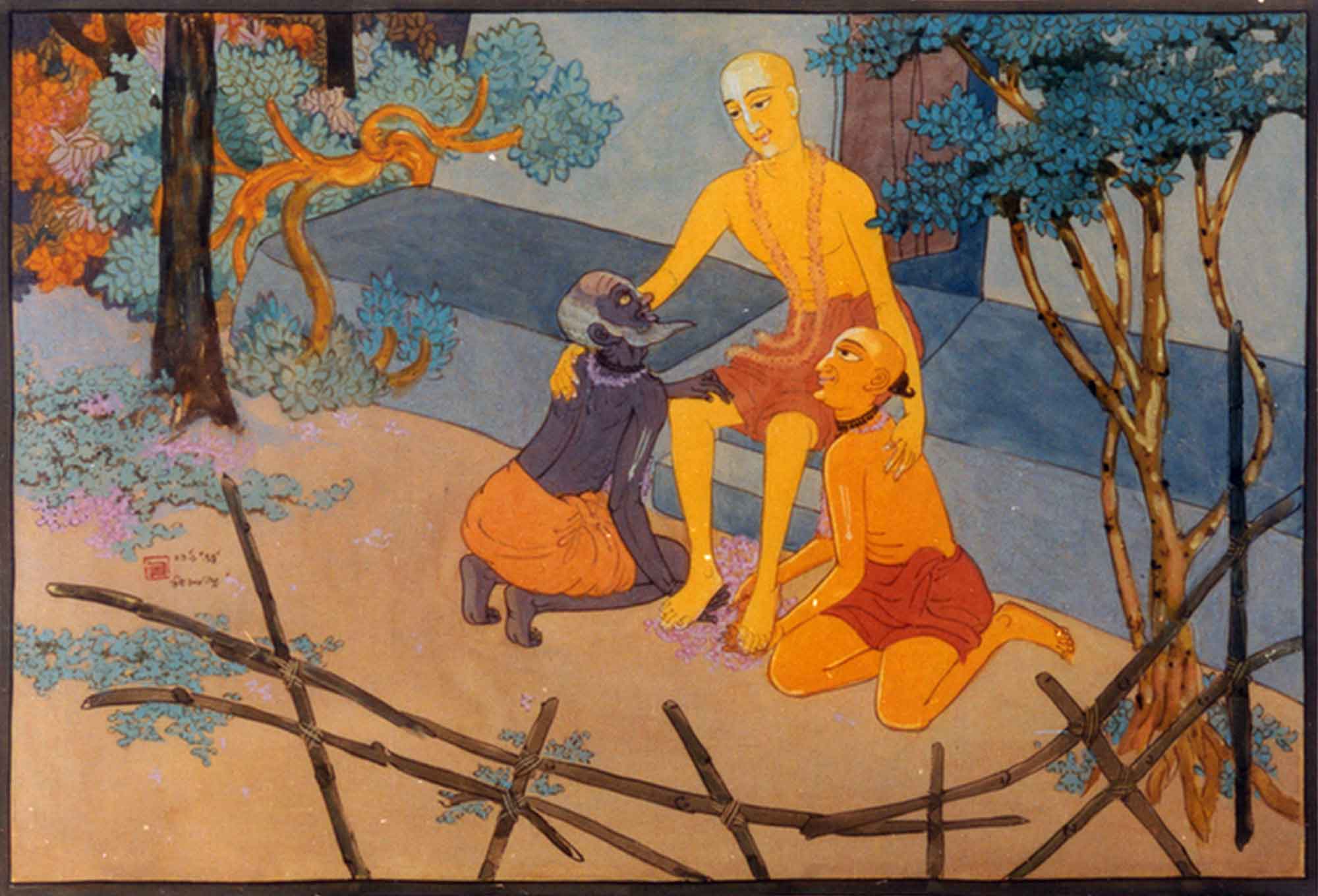Overview
Śrī Śrī Sanātana Gosvāmī Prabhu was first published in Sajjana Toṣaṇī Vol.2. issue 7 in 1885. In this brief biography, Bhaktivinoda Ṭhākura talks about the life of Sanātana Gosvāmī and also about the various apa-sampradāyas that lay claim to him. He gives Sanātana's genealogy, and at the end of the article, the Ṭhākura laments that Sajjana Toṣaṇī is not receiving enough support.
(translated by Swami B.V. Giri)
Śrī Sanātana Gosvāmī Prabhu was born in Yaśohara (Jessore), Bengal, in a village called Fateyabad, and was born in the Karṇataka Yajur-vedī brāhmaṇa dynasty. During his childhood, Sanātana followed Vaiṣṇava dharma. He studied all the śruti śāstra etc, with Vidyāvacaspati and especially established himself in that society. Sanātana’s material intelligence was also excellent. For this reason the Muslim king of Gauḍa appointed him as his secretary. From the time when, for His own sacred purpose, Śrī Śrī Śacīnandana Mahāprabhu went to Bengal, Sanātana’s mind was filled with asceticism and he always meditated upon Mahāprabhu’s feet within his heart. How long will Mahāprabhu not fulfill the desires of the devotees? In a very short time, Sanātana appeared at the feet of Mahāprabhu in Kāśī-dhāma.
When Sanātana, the recipient of Mahāprabhu’s mercy, took darśana of the sweet form of Mahāprabhu, he had a beard and mustache. That beard and mustache is the only pramāṇa (evidence) that the Bāula Vaiṣṇavas have for keeping a beard and moustache. But Mahāprabhu immediately lovingly embraced Sanātana and had him shave. Thus, at that time, the uncuttable pramāṇa of the Bāula Vaiṣṇavas was cut by the razor of human beauty. It is generally accepted, however, that the Bāulas cannot be accepted as Vaiṣnavas of the Śrī Caitanya sampradāya.
Because it is mentioned that Sanātana was dressed as a fakir, the Saiṅ, Daraveśa, Caraṇapālī, Dulālcāndī etc. and many other Muslims, accept the robes of a fakir and behave accordingly, identifying themselves as Vaiṣṇavas of the Caitanya sampradāya. If someone asks them that, “You dress as Muslim fakirs and basically behave like them. What is the proof that you are Vaiṣṇavas of the Caitanya sampradāya? In answer to this question, they say, “The proof of this is that Gosāi Sanātana was a fakir.” But when Mahāprabhu had Sanātana remove his moustache and beard, shave his head and accept the dress of a Vaiṣṇava, the proof of the Saiṅ, Daraveśa, Caraṇapālī, Dulālcāndī etc. ends there. For this reason, far from being Vaiṣṇavas of the Caitanya sampradāya, it should be said that the Saiṅ, Daraveśa etc. are some section of the sampradāya of Mohammed.
In fact, some people claim that Sanātana, Rūpa and Jīva Gosvāmī were Muslim. For now, we will quote from the book Bhakti Ratānkara concerning these Gosvāmī’s ancestors in order to dispel the misconceptions of all those people:
śrī-jīva gosvāmīra sapta-puruṣa-pracāra
prathama haite nāma kahi tā sabāra
(“I will now discuss the seven generations of Śrī Jīva Gosvāmī, and will give everyone’s names from the beginning.”)
śrī-sarvajña jagad-guru nāma vipra-rāja
mahā-pūjya yajur-vedī gotra bhardvāja
(“The king of brāhmaṇas was named Śrī Sarvajña Jagad-guru. He was most worshippable. He was a Yajur-vedī of the Bharadvāja gotra.”)
tāṅāra putra aniruddha-deva indra-sama
candre-u karaye spardhā yaśa sarvottama
(“His son, Aniruddha-deva, was like Indra, and his excellent fame rivaled that of Candra.”)
mahī-pati-pūjita devajña lakṣmīvāna
pṛthivīte vikhyāta mahiṣī-dvaya tāna
(“He was honoured by kings for his proficiency as a priest and for possessing all good qualities. His two queens were also famous well known everywhere.”)
rūpeśvara hari-hara nāme putra-dvaya
bahu-guṇa sarvatra vidita atiśaya
(“Rūpeśvara ad Hari-Hara were the names of his two sons, who were well known for their many qualities.”)
śāstre vicakṣaṇa jyeṣṭha putra rūpeśvara
śastre mahā-pravīṇa kaniṣṭha hari-hara
(“The eldest son, Rūpeśvara was renowned for his knowledge of śāstra. The younger son, Hari-Hara, became expert with weapons.”)
vibhāga kariyā doṅhe diyā rājya bhāra
śrī-kṛṣṇera dhāma prāpti haile pitāra
(“The kingdom was divided between the two, and their father attained the abode of Śrī Kṛṣṇa.”)
kata-dina pareloka saṁghaṭa kariyā
laila jyeṣṭhara rājya-kaniṣṭha hariyā
(“Sometime later there was a clash, and the younger brother stole the kingdom from his older brother.”)
rājya gela rūpeśvara-patnīra sahate
aṣṭa aśve-yukta āilā paustya deśete
(“Having lost the kingdom, Rūpeśvara and his wife travelled to Paustya-deśa in a chariot pulled by eight horses.”)
śrī-śikhareśvara sakhyatāte sukha pāi
rūpeśvara deva vāsa karila tathāī
(“There, he found happiness in the friendship of Śrī Śikhareśvara who convinced Rūpeśvara to remain there.”)
śrī-rūpeśvarera putra padmanābha nāma
parama sundara sarva-guṇe anupāma
(“Śrī Rūpeśvara’s son was called Padmanābha, who was extremely handsome, possessed all good qualities and was most intelligent.”)
padmanābha-deva se śikhara bhūmi haite
āilena gaṅgā-tīre vāsa spṛhā cite
(“Padmanābha-deva left the land of Śikhareśvara and settled on the banks of the Gaṅgā.”)
nava-haṭṭa grāme vāsa kailā mahāśaya
naihāṭī nāma yāra sarva-loke kaya
(“That gentleman resided in the village of Nava-haṭṭa, which everyone called by the name Naihāṭī.”)
tathā padmanābha-deva mahā-harṣa-chite
śrī-puruṣottama-mūrti pūjaye yatnete
(“There, with great bliss in his heart, Padmanābha-deva worshipped the Deity of Puruṣottama-Jagannātha.”)
kari yajña, utsava paramānanda haila
aṣṭādaśa-kanyā pañca-putra janmāila
(“He performed a yajña and organised a festival with great bliss. Thus, eighteen daughters and five sons were born to him.”)
śrī-puruṣottama, jagannātha, nārāyaṇa
murāri, mukunda ei putra pañca-jana
(“The five sons were Śrī Puruṣottama, Jagannātha, Nārāyaṇa, Murāri and Mukunda.”)
puruṣottama jyeṣṭha, sarva-kaniṣṭha mukunda
sarvāṁśe pravīṇa sarvottama guṇa-vṛnda
(“Puruṣottama was the eldest and Mukunda was the youngest amongst them. Of all the sons, they were the best in terms of their proficiency and qualities.”)
śrī-mukunda-devera nandana śrī-kumāra
vipra-kula-pradīpta parama śraddhācāra
(“The son of Śrī Mukunda-deva was Śrī Kumāra. He was a shining light in the brāhmaṇa dynasty, and possessed great śraddhā and conduct.”)
yadi akasmāt kabhu dekhaye yavana
kare prāyaścitta anna nā kare grahaṇa
(“If by chance he saw a Muslim, he would perform atonement and he would not accept any food.”)
jñāti-varga haite udvega haila mane
chaḍilena ‘nava-haṭṭa’ grame sei kṣaṇe
(“Due to problems with his family he became disturbed and immediately left the village of Navahaṭṭa.”)
nija-gaṇa saha baṅga-deśe śīghra gelā
‘bāklā-candradvīpa’ gramete vāsa kaila
(“He travelled to Bengal with his followers and lived in the village of Bāklā Candradvīpa.”)
yaśore ‘phatayabād’ nāme grāma haya
gatāyāta hetu tathā kārila ālaya
(“There was a village called Fateyabad in Jessore where he built a house for the sake of convenience.”)
kumāra-devera haila aneka santāna
tāra madhye tin putra vaiṣnavera prāṇa
(“Kumāra-deva had many offspring, and amongst them were three sons who were the very life of the Vaiṣṇavas.”)
rūpa, sanātana, śrī-vallabha – ei traya
sva-gotra anyatra ye arcita atiśaya
(“These three were Rūpa, Sanātana and Śrī Vallabha, who were the most worshippable members of their dynasty.”)
Śrī Vallabha’s son was Jīva Gosvāmī Prabhu. Here we have glorified the ancestry of our Rūpa-Sanātana. But it seems that Rūpa-Sanātana had other names previously, because when Sanātana and Rūpa were appointed as the chief employees of the king of Gauḍa, Hussain Shah, then due to his mlechha nature, Hussain Shah changed the name of Sanātana to Dabīr Khāsa and the name of Rūpa to Sākara Mallik. In this way, Śrī Śrī Mahāprabhu has given the name ‘Sanātana’ to Dabīr Khāsa, and the name ‘Rūpa’ to Sākara Mallik. Let us discuss the main point without saying anything more about this now.
Śrī Śrī Caitanya Mahāprabhu bestowed His full potency to Sanātana, and sent him from Kāśī to rescue the lost holy places of Śrī Vṛndāvana. Empowered by Mahāprabhu’s potency, Sanātana travelled to Vṛndāvana in great bliss, where he joined his brother Śrī Rūpa and the other devotees, and engaged in rescuing the holy places, revealing Deities, and writing many books on bhagavad-bhakti as taught by Mahāprabhu.
O reader! The Vaiṣṇava world is completely indebted to Sanātana and the Gosvāmīs. How can we satisfy you by glorifying the life and character of all the Gosvāmīs, when Bhakti Devī (Sajjana Toṣaṇī) remains weak, unclean and still afflicted with many troubles?













